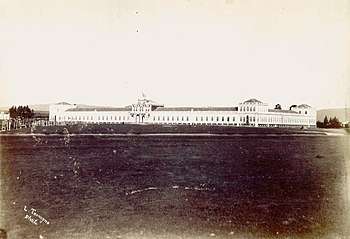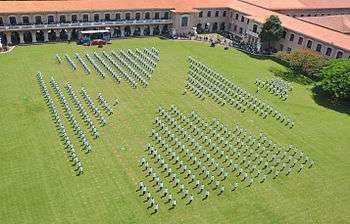Escola Preparatória de Cadetes do Exército
The Escola Preparatória de Cadetes do Exército - EsPCEx (Brazilian Army Preparatory School of Cadets) is located in Campinas, São Paulo, Brazil. It is an institution with more than half a century of existence, and its mission is to prepare candidates for entering Academia Militar das Agulhas Negras (AMAN), where combatant officers of the Brazilian Army are prepared.
To enter the Preparatory School students must pass an examination that occurs every year, for male youngsters who are studying at the high school third year or have already accomplished that level. The course at the Preparatory School is compared to the first year at a regular higher education institution, added by the military subjects which are necessary to the future cadet of AMAN. Among other, military instruction is included in order to prepare the candidates to the subjects that are taught at AMAN and are very important to the military career, with emphasis on physical preparation by means of physical training.
After accomplishing the course, students are admitted to AMAN or get the Reserve Certificate for the military service they have performed at the Preparatory School. From 2012 on, the School started to be the first level of the period of five years of the course for Brazilian Army Battle Commissioned Officers; the other four levels of the course are supposed to be performed by students at AMAN.
History
Origins

The preparatory teaching in the Brazilian Army began in 1939, with the transformation of Colégio Militar de Porto Alegre into "Escola de Formação de Cadetes", later named Escola Preparatória de Porto Alegre (EPPA). When EPPA turned to be not sufficient for the Army's needs, the Staff of the Brazilian Army created other Preparatory Schools to receive the number of volunteers that were interested in the military career. In 1940, the Escola Preparatória de Cadetes de São Paulo (EPSP), started temporarily, in a building formerly used by the Hospital Sírio-Libanês, on Rua da Fonte, nº 91, in the Bela Vista area of the city of São Paulo. In 1944, the facilities of Escola Preparatória de Cadetes do Exército (EsPCEx) were built at the former Chapadão Farm area, in Campinas, according to a design in a Spanish style, made by the famous architect Hernani do Val Penteado. In 1942, Escola Preparatória de Fortaleza (EPF) was also founded. In 1946, among the students, SRL (Sociedade Recreativa e Literária) was created, representing all the alumni and their interests in their school life. In that year the first promenade happened in the majestic Teatro Municipal de São Paulo. EPSP was active for 18 years, until 1958. In 1959 the EPSP was moved to Campinas, and was then called Escola Preparatória de Campinas (EPC). The three Preparatory Schools lasted along the 1940s and 1950s in very intense work. In 1961 they were abolished, leaving only EPC. The students from Fortaleza and Porto Alegre were transferred to Campinas. In 1962, the admission test was abolished and would be used again in 1963, on December 31. The Campinas society, led by the EPC Commander, was mobilized to avoid the EPC extinction. On November 17, 1963, the request was finally accepted. So the honorable school continued its mission of preparing those who were to be Cadets of Caxias.
Transfer to Campinas

The transfer of the School to Campinas starts at the beginning of the 1940s, with the managements of the federal intervenor Fernando Costa, who ruled São Paulo state. In order to Campinas be the seat of a Preparatory School Cadets, the cost of its installation were paid by the state government. The initial donation of the land was made by the Decree-Law 13,906, of March 20, 1944, only waiting for the end of the construction work to start existing as a school.
Accepted the way of turning the idea possible, through an agreement between the Ministry of War and the state, the architect Val Hairstyle Hernani undertook the project and justified it this way: "This project is a set of four pavilions, around a huge arms square and, for ease of movement, counting on large galleries in the inner face. Why four pavilions? Because three of them were destinated to the students in preparation for each of the three armed forces (Navy, Army, Air Force) , and the last pavilion was done to the basic course which was attended by the freshmen. "
After choosing the area in the region of Chapadão Farm, in the North of Campinas, the construction of the school began in 1944. The Government of São Paulo State led the work until the covenant stage and then pass it to the Ministry of War, who would have to complete it. Because of its magnitude, and without resources to finish the construction, the work stopped for some years and the school was abandoned. The state, therefore, annulled the donation made in 1944.
In 1958, the Army became interested in the project again. Contacts made by the then Commander of the Second Army with the State Government resulted in a message to the Legislative Assembly, dated April 29, 1958, transmitting the Law Project number 555, which authorized the State Treasury to sell, on giving to the Ministry of War, the property for the installation of the Preparatory School of Cadets in Campinas.
The evaluator of the State, when assessing the Law Project said: "The building was built for military purposes, because its original destination was the installation of a preparatory school of cadets in Campinas. Its external appearance and its appearance as a whole, however, does not denounce a headquarters. It's beautiful and pleasing to look, with its colonial style facade. Its structure, too heavy, is what it shows for what purpose it was built. It was anticipated, of course, a inexpugnable fortress.
The Finance Committee of the Legislative Assembly, to give its assent to the donation, wrote: "It is a measure of maximum interest to the Ministry of War and also to our state, in whose territory will be installed an educational establishment for the preparation of future Army officers. " The donation of the property occurred, solemnly, on August 25, 1958. Finally, in the following year, the school was transferred to Campinas.
Extinction
The difficulties were not restricted only to the construction. Decree Number 166 of November 17, 1961, turned the Preparatory Schools of Army Cadets of Porto Alegre and Fortaleza into lower-level Military Schools (Colégios Militares) and its Article 3 read: "The Preparatory School of Army Cadets in Campinas will be extinguished on December 31, 1963, and from the academic year 1962, it will no longer receive new students for the first year."
Public opinion from Campinas rose up against that measure and pressed the government for the permanence of the educational establishment in the city. The decision was revoked on November 26, 1963, when the deadline for its closure was almost expiring.
Reinauguration
The finishing works were restarted in 1967, and its name was changed from "Preparatory School of Campinas" to "Preparatory School of Army Cadets." The changes involved their physical area, its facilities, its servers and its curriculum.
For many years, from its arrival to Campinas to 1991, the School taught the 3 years of High School. Since then, the Army has been adopting the current (one year) model. . There are annually about 520 students from the various regions of Brazil who live in a boarding school system, where they receive, besides lessons and instructions, uniform, meals and per diem. Within the institution, students are divided into three companies (Eagle, Lion and Panther), and each of them has five platoons, totaling 15 platoons throughout the school.
Ordinance 152 of the Army Chief of Staff, on 16 November 2010, implemented the new system of the Higher Education Course for Brazilian Army Battle Commissioned Officers. The course of Bachelor of Military Sciences changed to five years; the first year at EsPCEx and the remaining four at AMAN. At that time, many subjects that are not directly related to the military profession started to be taught in the school. Military education has also been enhanced, which allowed AMAN a greater availability of time to teach some subjects that are important to the new demands of the 21st-century combat officer.
In the late summer of 2017, the school welcomed its first batch of women officer cadets.
The School today
The mission of the School

To Select and prepare the future cadet of the Agulhas Negras Military Academy (AMAN), initiating the formation of the Brazilian Army battle commissioned officer.
The Course
The school year includes the academic period, the school recess and the school holidays (between the graduating ceremony and the beginning of the course the following year). The beginning and the closing of the academic period are formalized by military ceremonies. EsPCEx is a boarding school where the students have to attend to all school activities which are considered to be service acts. Classes and all school activities have a duration of 50 minutes. The student must obtain a grade of 5.0 in all subjects in order to graduate at the end first year:
- Calculus I
- Physics
- History
- Military Instruction
- Shooting,
- Organization
- Preparation and Usage of the Army Ground Force
- Military Physical Training I, II, III
- Spanish I
- English I
- Portuguese I
- Chemistry Applied to the Military Sciences
- Information Technology and Communications
There is also an exam that tests all the subjects studied through the year, and the student must be considered apt in terms of Military Discipline.
The student receives at graduation the School Certificate including all the subjects studied and the Certificate of Reservist of the 2nd Category. If the student doesn't get the necessary grade to finish the course he may do the final exams a second time. If he does not pass one or more subjects, he will have to return a second year, and study that the subject at EsPCEx in the following year as well as Military Instruction, Spanish, and English. That second year, the student must pass.
Professional military teaching
Military teaching at the school, is not aimed at educating combatants who belong to a constituted section. It is rather intended for creating a taste for the job and for discipline. The education of the basic military man is developed with solid knowledgement and practice, so that, at AMAN, he can be posted to combat sections and save time that would otherwise be spent on reviewing individual combat techniques.
Problem solving
Since 2012, the school has adopted the Teaching through Competences methodology, the first military school in Brazil to implement this methodology. In this method, knowledgement must be contextualized and integrate the syllabi of the different disciplines into problem-solving situations. With the use of this methodology, students have to reflect and solve problems in a systemic and integral way.
Health preparation and physical training (PT)
PT is aimed at the student's physical preparation and healthy conditions, to give a transition from the civilian (normally sedentary) life to a cadet's intense routine. The aim is not to form the combatant in physical terms in only one year at the School, but to form the basis for the student to be prepared at the Academy. Among the key activities are non-stop running, swimming and circuit training. Sports activities are planned to develop the taste for competition or leisure through sports, which will follow students through most of their professional lives. Competitive training at the School focuses mostly on building the basis for sports teams at AMAN.
See also
References
Bibliography
- Cappellano, Jorge Luiz Pavan (Coronel R1). Memorial da Escola Preparatória de Cadetes do Exército: da Rua da Fonte à Fazenda Chapadão, 65 Anos de História Campinas/2010 - Impressão Digital do Brasil Gráfica e Editora Ltda.